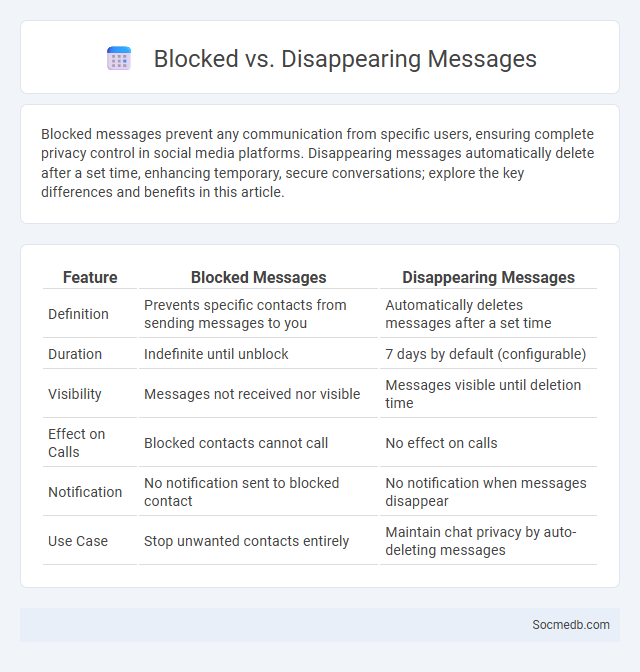
Photo illustration: Blocked vs Disappearing Messages
Blocked messages prevent any communication from specific users, ensuring complete privacy control in social media platforms. Disappearing messages automatically delete after a set time, enhancing temporary, secure conversations; explore the key differences and benefits in this article.
Table of Comparison
| Feature | Blocked Messages | Disappearing Messages |
|---|---|---|
| Definition | Prevents specific contacts from sending messages to you | Automatically deletes messages after a set time |
| Duration | Indefinite until unblock | 7 days by default (configurable) |
| Visibility | Messages not received nor visible | Messages visible until deletion time |
| Effect on Calls | Blocked contacts cannot call | No effect on calls |
| Notification | No notification sent to blocked contact | No notification when messages disappear |
| Use Case | Stop unwanted contacts entirely | Maintain chat privacy by auto-deleting messages |
Introduction to Messaging Privacy Features
Messaging privacy features on social media platforms include end-to-end encryption, which ensures that only the sender and receiver can access the content of messages. Users can control who can see their status, read receipts, and last active times, enhancing personal security. Advanced options such as disappearing messages and biometric authentication provide added layers of protection against unauthorized access.
Understanding Blocked Messages
Blocked messages on social media occur when your account or message is restricted from reaching a recipient due to privacy settings, spam filters, or platform policies. These blocks prevent your content from being seen or received, impacting your ability to communicate effectively with others. Understanding why messages get blocked can help you adjust your approach to ensure your social interactions remain smooth and compliant with platform rules.
Disappearing Messages: How They Work
Disappearing messages automatically delete content after a set period, enhancing privacy by limiting digital footprints on platforms like Snapchat and Instagram. These messages use timers or view-based triggers to erase texts, images, or videos, preventing long-term access or storage. This feature supports confidential communication and reduces risks of data breaches in social media interactions.
Key Differences Between Blocked and Disappearing Messages
Blocked messages prevent any communication from the sender, effectively stopping all incoming texts or media from that user without notification. Disappearing messages automatically delete themselves after a set time, enhancing privacy by removing conversation history without blocking the contact. Understanding these differences helps users manage privacy controls and message visibility on platforms like WhatsApp, Instagram, and Facebook Messenger.
What Happens When You Block Contacts
When you block contacts on social media, they lose the ability to view your profile, send messages, and interact with your posts. Notifications about the block are not sent, but the blocked user may notice restricted access or unresponsiveness. This action enhances privacy by preventing unwanted communication and limiting visibility within the platform.
Notifications and Visibility: Blocked vs Disappearing
Blocked users on social media are prevented from sending notifications or viewing your activity, ensuring complete invisibility from your account. Disappearing content, such as Stories or temporary messages, remains visible only for a limited duration but still allows notifications and visibility within that timeframe. Understanding the difference enhances control over who sees your content and how interactions are managed on platforms like Instagram, Facebook, or Snapchat.
User Control: Managing Messaging Privacy
User control in social media platforms enables individuals to manage messaging privacy through customizable settings that regulate who can send messages and view conversations. Advanced privacy features include end-to-end encryption, message expiration, and selective audience targeting to protect sensitive information. Empowering users with granular controls reduces unauthorized access and enhances overall communication security.
Security Implications: Block, Disappear, or Block Contacts?
Social media platforms present significant security implications, especially concerning options like blocking, disappearing messages, and managing blocked contacts. Blocking users helps prevent unwanted interactions and protects personal information from potential cyber threats, while disappearing messages enhance privacy by automatically deleting sensitive content after a set time. Managing blocked contacts effectively reduces exposure to harassment, phishing attempts, and identity theft on platforms such as Facebook, Instagram, and Twitter.
Practical Scenarios: Choosing the Right Feature
Selecting the appropriate social media feature depends on target audience engagement and campaign objectives, such as leveraging Instagram Stories for ephemeral content or LinkedIn Articles to reach professionals. Brands aiming to boost real-time interaction benefit from live streaming features, while businesses focusing on long-form content should utilize blog integrations and video uploads. An informed choice drives higher conversion rates by aligning platform functionalities with specific marketing goals and user behaviors.
Conclusion: Best Practices for Message Privacy
Ensuring message privacy on social media requires using end-to-end encryption, regularly updating privacy settings, and being cautious about sharing sensitive information. Leveraging platform-specific security features like two-factor authentication enhances protection against unauthorized access. Consistently reviewing app permissions and staying informed about privacy policies further safeguards personal data.
 socmedb.com
socmedb.com